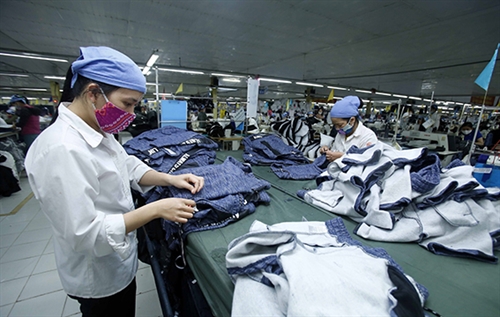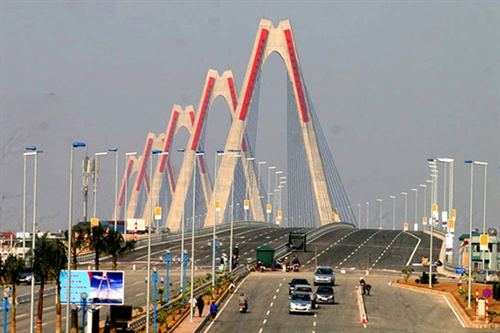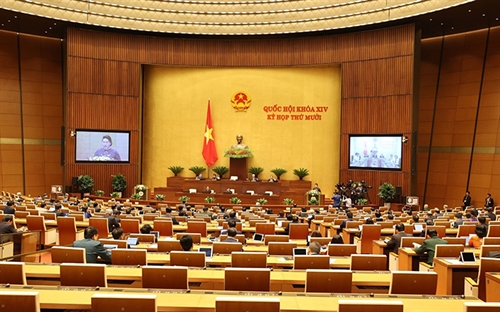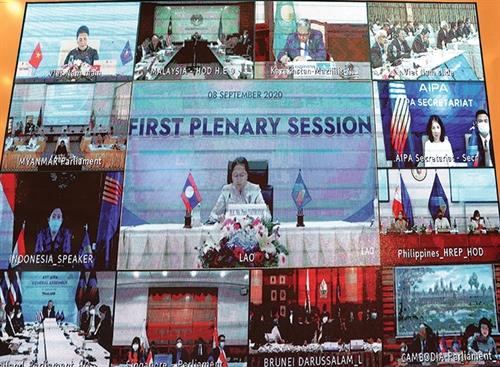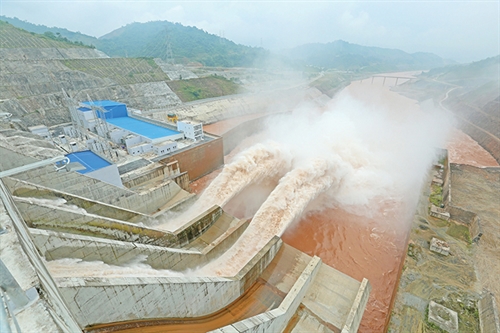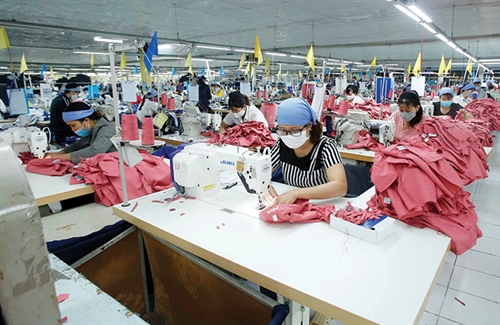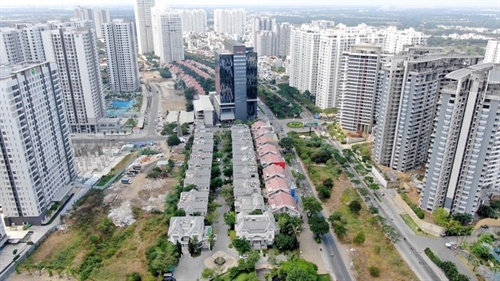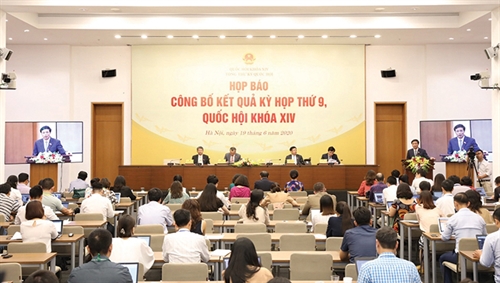Dr. Tran Tuan Anh
Member of the Party Central Committee
Minister of Industry and Trade
Contributions of the processing and manufacturing industry to GDP and job creation
The gross domestic product (GDP) of a country is structured from different economic activities, which are normally grouped into three main economic sectors: agriculture, industry-construction and service. Agriculture and industry-construction create tangible products while services generate intangible ones. Tangible and intangible products are closely inter-related according to value chains and both bring about value for the economy. A value chain is a chain of operations that converts an idea into a specific product. After a product goes through a certain operation process, its value further increases.
The industrial sector is composed of four main industries: mining; processing and manufacturing; electricity and gas production and distribution; and water production and drainage, in which the second plays the leading role, generating the largest added value for the industrial sector. In industrialized countries, over the past 20 years the processing and manufacturing industry has always accounted for about 20 percent of GDP. In 2019, it represented 27.1 percent of GDP in China; 25.3 percent in the Republic of Korea; 25.3 percent in Thailand; 21.5 percent in Malaysia; 20.7 percent in Japan; 19.8 percent in Singapore and 19.4 percent in Germany. In Vietnam this ratio stood at just 16.5 percent.
Since 2010, Vietnam’s economic structure has witnessed a strong shift toward industrialization, with a reduction in agricultural share and an increase in industrial and service contributions. Four sectors with largest contributions to the economy include processing and manufacturing; agriculture; wholesale and retail service; and mining, while the rest has contributed less than 5 percent each. So, the processing and manufacturing industry has served as a driving force for the country’s economic development.
The processing and manufacturing industry generates long-term jobs and stable incomes. In 2019, it created 28.2 percent of total jobs in China; 26.8 percent in Germany; 24.8 percent in the Republic of Korea; 27.2 percent in Malaysia; 23.4 percent in Thailand; and 25.8 percent in Vietnam.
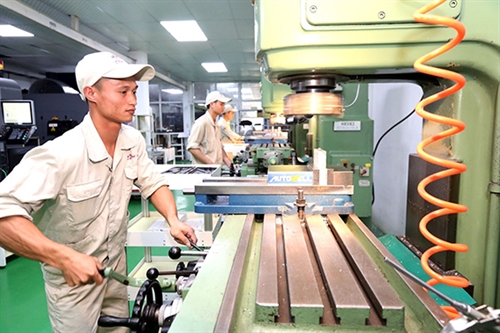 |
| Manufacturing precision mechanical products at Hanoi-based PMTT Automation Joint Stock Company__Photo: Anh Tuan/VNA |
Owing to its economic restructuring efforts, Vietnam’s labor structure has witnessed a significant reduction in agricultural labor from 49.5 percent in 2010 to 37.7 percent in 2018 and an increase in industrial and service labor. The processing and manufacturing industry has played its leading role by absorbing a large number of agricultural laborers, which rises from 13.5 percent to 17.9 percent. It was followed by wholesale and retail services with their labor ratio rising from 11.3 percent to 13.5 percent. The labor ratio in the remaining sectors represents less than 10 percent. So, over 60 percent of the national workforce are working in three main sectors: agriculture; processing and manufacturing industry; and wholesale and retail services. With the trend of gradual reduction of agricultural labor in the coming period, the processing and manufacturing industry as well as wholesale and retail services must create more jobs to meet the country’s employment demand.
Within the processing and manufacturing industry, textile, leather and footwear and food processing remain to be major job creators with the average employment growth rate of 6 percent in the 2014-17 period. The electronic industry has become more labor-intensive with an employment growth rate of 21 percent in the same period. Other sectors such as rubber-plastic, mechanical engineering and car manufacturing also tend to employ more labor in line with the industrial restructuring, with an expected average growth rate of over 8 percent.
Vietnam is now in the period of golden population with over 50 percent of its population being in the working age group. In order to fully tap this opportunity, beside job creation, attention should be paid to employment quality, namely creating jobs with high labor productivity and income, which are factors to boost economic growth. If importance is attached only to quantitative growth focusing on the development of labor-intensive industries in order to create more jobs, but not to employment quality as well as the restructuring of the processing-manufacturing industry from a labor-intensive and low-productivity to a capital-intensive and technological one with higher productivity, labor will become scarce when Vietnam’s golden population period is over.
So, job creation will not be effective if it is based only on the employment structure in the processing and manufacturing industry since such labor-intensive industries as textile and footwear can generate numerous jobs but have a low labor productivity. Vietnam’s textile and footwear industries now depend largely on foreign enterprises which hold all high added value-generating processes, as they only perform processing contracts for foreign brands and a production process generating low added value.
Processing and manufacturing industry and the target of becoming a modern industrialized country
If maintaining the current growth rate of the processing and manufacturing industry, in several years to come, Vietnam can join the group of newly emerging industrialized countries under the classification criteria of the United Nations Industrial Development Organization (UNIDO), which regards the per-capita manufacturing value added (MVA) as a principal index reflecting the industrial production development level in relation to the population size of a nation.
A nation is classified as a “newly emerging industrialized economy” if it has recorded considerable industrial achievements and reached an adjusted average per-capita MVA of between USD 1,000 and 2,500 or a per-capita GDP of between USD 10,000 and 20,000.
Currently, Vietnam is a developing economy with the adjusted per-capita MVA approximating USD 1,000. If maintaining a high MVA growth rate of over 8 percent, it will meet the criteria to join the group of newly emerging industrialized economies under UNIDO’s criteria in five to seven years to come.
Correlation between the processing and manufacturing industry and services - policy orientations in the coming period
Recently, with the signs of a lower industrial growth rate than the service growth rate, some people think that in the present context with the availability of new technologies of the 4th industrial revolution, the processing and manufacturing industry will no longer play an important role as before and the service sector will act as a driver for economic development, helping advance medium-income countries to high-income ones, and that industrialization-based development is no longer appropriate in the context that technologies and technological services strongly develop as at present. However, such assessment is only based on figures but ignores the structure of the entire value chain as the service sector largely depends on the development scale and level of production industries. In other words, the service sector cannot develop without production industries.
The service sector is composed of 15 different branches classified into four main groups: (1) Distribution service (wholesale, retail, transport, storage); (2) Services provided for manufacturing industries (communications, finance, insurance, equipment leasing, advertisement); (3) Social services (public administration, security-defense, education-training, health); and (4) Personal services (hotels, restaurants, entertainment, culture).
Of these services in almost all developed or developing countries, the distribution services often account for the largest ratio of 15-20 percent of GDP, but wholesale and retail are in essence activities buying and selling commodities turned out by the processing and manufacturing industry while the logistics, transport and storage services cannot develop without the exchange of goods turned out by production industries. Even medical and tourist services actually consume products of the processing and manufacturing industry, such as medical equipment, medicines and pharmaceuticals in healthcare, and consumer goods at hotels and restaurants. So do financial and professional services like consultancy, research and development, education and training, etc., which cannot exist and develop without manufacturing industries.
In short, the health of an economy largely depends on the health of the manufacturing sector. The US-China trade war and the COVID-19 pandemic stress the importance of self-sufficient production and value chains and a close association between production and services. Obviously, a model of economic growth is determined not by selecting between industries and services but by identifying that production is the core and production services always go along with production, serving production and creating added value for production industries. For example, Singapore, a small country with limited resources but geographical advantages, can focus more on services and rely on production of other countries. However, its processing and manufacturing industry’s ratio in GDP still approximates 20 percent.
For Vietnam, with a population of nearly 100 million, young population structure, high employment demand and nearly 70 percent rural population, to be independent and prosperous, its economy must comprise a developed and strong processing and manufacturing industry for fast and sustainable modernization and urbanization. Strong development of the production sector as well as processing and manufacturing industry will attract labor from rural to urban areas, from agriculture to industry and services, thus creating conditions for the accumulation of agricultural land and scientific-technical application to raise the added value and efficiency in agriculture.
The above figures and conclusions show that the processing and manufacturing industry plays an important role in the economy. In order to maintain a high economic growth rate and avoid the medium-income trap, in the coming period, Vietnam should continue with the objective of industrialization, regarding the processing and manufacturing industry as the core while effectively developing distribution and production services in order to create a double impetus for economic growth. Developing the processing and manufacturing industry will create markets for services to develop. Developing a strong domestic processing and manufacturing industry also helps create a firm foundation for the development of services and in return, the efficient development of services serving the production sector also contributes to raising the productivity and operation efficiency of the industry.
Medium-income trap and how to avoid it
Medium-income trap is understood as a situation when a nation reaches a certain income level thanks to its available advantages but cannot pass such income threshold. The medium-income trap occurs when a developing country cannot lift its average per-capita GDP of between USD 1,000 and 12,000 under the World Bank’s criteria.
The development of different countries over the past 60 years shows that a number of them have succeeded in maintaining their continuous growth to become high-income nations such as Japan, the Republic of Korea and Singapore. According to the World Bank, Japan became a medium-income country in 1966, Singapore in 1971, the Republic of Korea and Malaysia in 1977, Thailand in 1988, Indonesia and the Philippines in 1995. Yet, by 2019, the average per-capita GDP of these countries were as follows: Japan: USD 40,248; Singapore: USD 65,233; Republic of Korea: USD 31,761; Malaysia: USD 11, 414; Thailand: USD 7,808; Indonesia: USD: 4,135; and the Philippines: USD 3,485.
The Asian Development Bank (ADB)’s study in 2017 pointed out that the average time for a country to advance from a low-income to a high-income nation is about 30-40 years. Within 40 years after reaching the medium-income level, should a country fail to become a high-income country, it will be regarded as falling into the medium-income trap.
The process of development from a low-income to a high-income economy varies in time and development motive from country to country. It took Japan and Singapore only 20 years with an average annual growth rate of 6-8 percent; the Republic of Korea only 18 years with an average GDP growth rate of 9 percent per year.
Regarding the development motive, it can be realized through the GDP structure with a gradual reduction in the agricultural ratio and an increase in the industry-construction and service ratios, especially the contribution of the processing and manufacturing industry to GDP. According to the World Bank’s data, in the Republic of Korea’s development process from 1977 to 1995, the agricultural ratio dropped from 22 percent to 5 percent; the industry-construction ratio rose from 28 percent to 36 percent (in which the processing and manufacturing industry ratio rose from 21 percent to 26 percent); and the service ratio rose from 39 percent to 49 percent. Similarly, in its 20 year-long development process from 1971 to 1991, Singapore witnessed its agricultural ratio shrinking from 3 percent to 0.2 percent, the industry-construction ratio rising from 28 percent to 33 percent (in which the processing-manufacturing ratio rose from 19 percent to 25 percent and the service ratio dropping from 64 percent to 63 percent).
Vietnam became a medium-income nation in 2008. The process of its economic restructuring took place at a slow pace without breakthroughs right from the beginning like Japan, the Republic of Korea or Singapore. From 2010 to 2019, the agricultural ratio dropped from 18.3 percent to 13.9 percent; the industry-construction ratio rose from 32.1 percent to 34.4 percent (in which the processing and manufacturing ratio rose from 12.9 percent to 16.4 percent); the service proportion rose from 36.9 percent to 41.6 percent. Vietnam’s average growth rate in the first 10 years was 6 percent, much lower than that of Japan (7 percent); the Republic of Korea (8.9 percent); and Singapore (8.8 percent).
Low-value added trap and internal strength of domestic industry
According to the United Nations Conference on Trade and Development (UNTAD), a country falls into the low-value added trap when it attracts foreign direct investment mainly from enterprises which do not intend to form links with the domestic economy, fail to create a widespread effect and operate for short-term objectives with low efficiency in all three aspects: Investment, productivity and skill development. They invest only in labor-intensive sectors, compete by prices instead of quality and delivery time, and usually view labor as a cost than a resource to be developed.
The low-value added trap is, by its nature, a manifestation of the medium-income trap, which occurs when a country fails to lay a firm and strong domestic industrial foundation (domestic private enterprises) and its growth relies mostly on foreign resources (FDI sector). When domestic advantages (low labor cost, attractive tax preferences, etc.) no longer exist, FDI enterprises will move to other countries with better advantages and competitive production cost, thus leading to the de-industrialization process, leaving the industry with domestic enterprises incapable of competing with technologically developed economies or with economies having low wage levels in the production of cheap commodities.
Right after opening its economy, Vietnam became an attractive destination for foreign investors. Over the recent years, Vietnam has always topped ASEAN countries in attracting foreign investment. By the end of 2019, Vietnam had attracted nearly 40,000 projects with a total registered capital of over USD 363.3 billion, surpassing China, India and most ASEAN countries in terms of per-capita GDP. Among the FDI projects in Vietnam, there are many high-value ones operated by various multinational groups in different fields. However, a majority of FDI projects in Vietnam have focused on the market-tapping sectors such as real estate business or labor-intensive processing and manufacturing industries with low value added, such as textile, leather and footwear, rubber and plastic products, foods and drinks, wood furniture, paper, etc. The World Bank’s 2018 report revealed that many investors said that low labor cost and energy expenses as well as attractive tax incentives were main reasons for them to invest in Vietnam while few FDI enterprises thought that high labor skills or competitive domestic supply chains were Vietnam’s strong points. The report also pointed out that in order to avoid the medium-income trap or low-value added trap, Vietnam should work out a strategy to attract FDI of new generation in conformity with the national development strategies and planning, forming many supply chains and industrial clusters, focusing on those generating high value added, using environment-friendly technologies with low energy consumption. Vietnamese authorities should seek to attract projects and investors for sustainable development by attaching importance to quality, socio-economic efficiency, security-defense maintenance and close connection with domestic enterprises.
In order to enable the FDI sector to contribute and render more support to Vietnam’s economy in the process of industrialization, modernization and economic restructuring toward raising productivity and locally created value and narrowing the gap with developed countries, Vietnam should alter its FDI attraction approach to be based on motive competitive advantages (laborers’ skills, innovation capability and favorable natural, business and investment environments), instead of static competitive and non-sustainable advantages as before (natural resources, unskilled labor, easy and attractive preferential mechanism). More specifically, Vietnam should attract foreign investors who can: (1) pay higher wages; (2) promote skills development, technological transfer, domestic research and development; (3) encourage the more efficient use of resources (energy, land, water, raw materials); (4) create opportunities for domestic enterprises and investors to cooperate with foreign enterprises in global value chains; and (5) raise the competitiveness of Vietnamese enterprises at home and overseas.
Policy orientations
On the road from a medium-income to high-income country, the processing and manufacturing industry cannot be ignored and domestic industrial enterprises themselves constitute an element promoting the sustainable economic development and the escape from the medium-income and low value-added traps. FDI in the processing and manufacturing industry is a conductive impetus but domestic industrial enterprises constitute a steady foundation for a country to get out of the medium-income trap. Therefore, FDI should be attracted selectively under a strategy. FDI enterprises with obsolete technologies should be barred in order to avoid the low value-added trap. It is necessary to develop strong domestic industrial enterprises in close association with the FDI sector, proceeding to building strong, domestic enterprises that can lead and form domestic supply chains.
Industrial development policy should be placed in a broader context, including policies directly affecting industrial enterprises and policies not directly affecting but having strong impacts on the development of the industrial sector in general and industrial enterprises in particular. In order to identify right objectives, a mechanism of coordination between the State and enterprises is required for striking a consensus between the government agencies as well as the Government and the private sector. So, it is necessary to form and maintain a mechanism for policy dialogue with industrial enterprises, monitoring, overseeing and assessing the policy quality improvement and industrial competitiveness of Vietnam as compared to other countries in the region and the world.
In order to attract high-value FDI, a number of mechanisms and policy barriers and challenges should be handled in light of the entire cycle of enterprises’ investment and the current approach to FDI should be altered. First, attention should be directed to investors with a motive for development based on skilled workforce and resources-conserving technologies instead of low labor cost and low infrastructure connection expenses. There should be unified criteria for investor selection from the central government to localities in order to ensure the attraction of investment strictly according to the economy’s demands. Activities of connecting domestic enterprises with FDI enterprises and building capability for domestic enterprises to participate in supply chains of FDI enterprises should be further carried out. Second, investment promotion should be done in a proactive manner with clear targets so as to attract investors needed by the economy instead of inactively opening the market and waiting for investors to come. Third, the investment marketing tools should be approached according to sectors and value chains in order to attract investors based on long-term advantages instead of traditional marketing instruments based on short-term cost advantages. The State should support and create most favorable conditions for production and business activities of existing foreign investors instead of organizing inefficient investment promotion events. Finally, incentives for investors should be based on efficiency and added value created domestically, and on post-investment results instead of registered capital amounts and scale of operation.-
